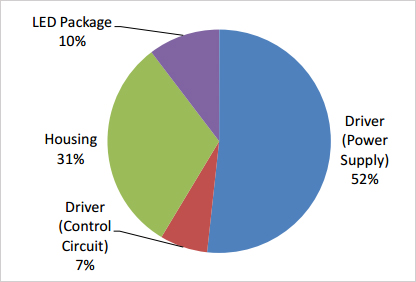Even if the LED emitters, or LED packages in various forms, from reputable manufacturers like CREE, Osram have established reports based on thousands of hours of data under varying conditions to back their claims. The failure of any LED luminaire component - not just the array of LED packages, but also the electronic components, thermal management, optics, electrical parts, and even design flaws or manufacturing defects can directly or indirectly lead to product failure. High quality LEDs can be incorporated into poorly engineered systems.
Here is a breakdown of failure analysis for a typical LED luminaire (Source: U.S. Department of Energy website)

As you can see the failure rate of drivers or driving circuits cannot be emphasized enough especially for LED lighting products. Given the long lifetimes of today's LED packages, the driver is the weakest point for most LED lights. LEDs rarely fail catastrophically, but may have parametric failures such as degradation or shifts in luminous flux, color rendering, luminous intensity distribution, color temperature, or luminous efficacy. Such premature failures are typically affected by the defect in driving mechanisms or thermal management systems.
I'm really skeptical of a manufacturer's extremely long warranty, say for 8 years or 10 years. Admittedly, there're very responsible promises from reputed manufacturers and brands. Even though the warranty these big players offer is not the full type. They provide only limited warranty by freeing them from liabilities that their customers can not foresee and control. Such liabilities include user's failure to comply with manufacturer's instructions, operation outside the specified electrical values, operation in abnormal environmental conditions, failure resulted from external causes, and more.
Most LED luminaires are non-serviceable products which means they can not be repaired in the field and will fail upon failure of any critical part, and will require complete replacement. Even with serviceable LED lights there will be high service fees charged by electricians or qualified engineers. Such replacement costs or service fees could be well above manufacturer's expectations, leading to a breach of warranty, which often happens on small- and middle-scaled overseas suppliers.
Let's be realistic. If an overseas lighting manufacturer claims a surprisingly long-term warranty for a low-price product, it's most likely a sales hype. Not a joke, such companies might have a life shorter than their product warranty. Go and find a reliable supplier with a solid warranty.












